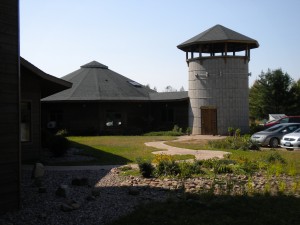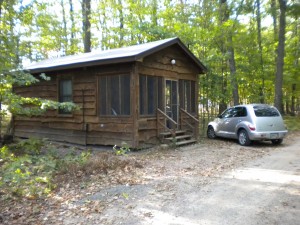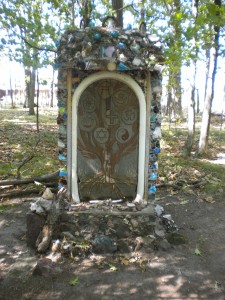Scenes from a Mindfulness Retreat: Introduction
 I’m feeling better now. Not that I’ve been feeling bad, exactly; on the contrary, I can tell you without exaggeration that I have had more moments of pure joy in the last two weeks than I have in many years. And that’s been the problem. How do you handle it when your heart opens wide, and refuses to close? When the sight of all the faces at the supermarket, or the expressions of businessmen around a conference table, bring you to the verge of tears? When you step back into the life routines you’ve lived for years and know in your bones that they will no longer do, and you are now compelled to figure out how to live differently?
I’m feeling better now. Not that I’ve been feeling bad, exactly; on the contrary, I can tell you without exaggeration that I have had more moments of pure joy in the last two weeks than I have in many years. And that’s been the problem. How do you handle it when your heart opens wide, and refuses to close? When the sight of all the faces at the supermarket, or the expressions of businessmen around a conference table, bring you to the verge of tears? When you step back into the life routines you’ve lived for years and know in your bones that they will no longer do, and you are now compelled to figure out how to live differently?
That feeling of my life being thrown into an ecstatic chaos is beginning to recede, as I continue to slowly and with much effort integrate the experiences I had at my first mindfulness retreat. It started on a Thursday afternoon and ended just shy of three days later. During that time I experienced first anxiety, then overwhelming sadness, and then a wild torrent of emotion that ebbed and flowed, sometimes into bliss, sometimes into heart-bruising agony. And I experienced a deep sense of love and connection with 30 people who were, and still are, for the most part, strangers.
Preparing to write this series of articles, thinking over their structure and beginning to draft outlines, paragraphs and sentences in my head, has been an important part of that integration process. It’s helped me put together a narrative to make sense of an experience that at the time often seemed overwhelming and bewildering. So I thank you, reader, for being there to speak to. Before I get into details, I want to give you a few general facts to serve as context for what’s to come.
This retreat, sponsored annually by the Department of Integrative Medicine at UW Health, took place over three days of glorious early autumn weather at the Christine Center just south of Willard, Wisconsin. This beautiful facility is located about as close to the middle of nowhere as it could be; if you stood in the woods surrounding it and listened very carefully, you could barely make out the sound of cars on U.S. Highway 10 about five miles away. The absence of city lighting anywhere nearby allowed the night to open up in silky blackness and reveal the galactic band of the Milky Way yawning across the top of the sky.
The Christine Center is run by a group of Franciscan sisters, whose eclectic dedication to the wisdom traditions of the world was everywhere in evidence. Yes, there were stained glass and crosses, and in the woods were little grottos for Jesus and Mary. But there were also paintings in the dining hall depicting the various chakra energies, and a grotto of crystalline stones, bottles, horseshoes and other odds and ends framing a wood carving of a tree in whose branches were nestled the symbols of the world religions. The main building consisted of three round structures connected by rectangular wings, like three big interconnected yurts: a chapel with stained glass windows; a building full of offices, conference rooms and living quarters; and a large round meditation hall surrounded by huge windows that let in the light and greenery from outside.
Across the gravel road from the main building, distributed through a wooded glade, were a number of huts – hermitages, they are called – for single or double occupancy. Some had been recently upgraded to include toilets and running water; others, like the small hut I was in, made do with a porta-potty. The huts were well made yet intentionally primitive in appearance; the walls of mine were tongue-and-groove joined knotty pine, but the wood was only lightly stained and the boards were rough cut and slightly uneven at the top. On the small screened-in porch, a flashing had been made by bending a sheet of aluminum and nailing it to the bottom sill with roofing nails. The furnishings were comfortable, but they had the borrowed look reminiscent of someone’s barely-finished basement. Each hut had a name, either the name of an archangel or a holy virtue, etched into a wooden plaque on the front wall; mine was named Wisdom.
The grounds were ringed by a birch forest (a rarity in Northern Wisconsin nowadays) through which small groups of deer moved throughout the day. At one end was a small farm pond around which were a few benches for contemplative sitting, again roughhewn but solidly made and beautifully finished. There was a fire pit with a metal ring surrounded by paving stones that was my favorite place to do walking meditation after breakfast; and at one corner of the property was a wood fired sauna with a stove that looked like it had been made from a section of old boiler; it drew nicely and heated quickly.
The entrance to the main building was a tall cylinder made of cinder block that looked like a farm silo but actually served as a bell tower. The bell rang at 7 a.m. to summon us to yoga or tai chi and meditation; again at 8 for breakfast, and at 9:30 for the morning practice session. It rang at noon for the main meal of the day, which was referred to as “supper”. It rang again at 2 or 2:30 for the afternoon practice session; at 6 for dinner; and at 7:30 for the final session of the day.
The three daily meals, served buffet style, were vegetarian but not vegan (thank heavens for milk, butter and eggs). We ate them in contemplative silence, and who knows whether that contributed to their amazing deliciousness. The fresh ingredients included vegetables grown on the property, and the recipes were wonderfully inventive. Grain-based meat substitutes were the first good-tasting ones’ I’d ever tried; fruit salads popped with gorgeous color; inventions like apple-squash soup, barbecue tofu, or kale blanched and served cold in a Japanese-style sesame dressing were always present; home-style breads from a local Amish bakery were served at every meal, and dessert was the kind of cakes and bars you might remember from a really good church bake sale. After the meal we quietly scraped our dishes into a compost bucket and placed the plates in a plastic bin and the silverware in a plastic bucket of soapy water. Thermos containers of coffee, ice water, and hot water for tea were available at all times, as was a bowl of fruit.
The practice sessions were presented by eight MBSR instructors from the Integrative Medicine Department, some of whom I recognized from the Friday evening sessions about which I have written here before; others were new to me. They worked in pairs, and apparently each pairing was responsible for planning the content of a session. When they were not leading a particular session, they took their places in the circle of participants, and practiced alongside of us, including participating in the dyad and small group discussions that were part of most exercises. The effect of this was to de-emphasize them as figures of authority; or, perhaps more accurately, it was to demonstrate that real authority grows from an attunement to the wisdom of practice, something that was equally available to each of us. If one wished, one could ask a teacher for a one-on-one meeting during the personal periods, an opportunity I took advantage of.
In that circle, arrayed on chairs, cushions, zafus, mats and seiza benches, were about thirty people. Most of us could be described as middle-aged, but there were also some in their twenties and thirties, and some I judged to be in their 70s. I was one of only four men in the group, one of whom was an instructor. There were two participants I guessed to be of Hispanic heritage, and that was the extent of racial diversity in the group. It was, in other words, a slightly larger version of the group I practiced with on Friday nights, although I recognized only two of my fellow participants from that group. I was surprised to learn that, unlike the Friday night group which is composed of alumni of a standard 8-week MBSR course, some of the retreat participants not only had not done the MBSR course, for some of them this was their first exposure to mindfulness practice.
Attendance at the practice session was not mandatory, and we were encouraged to use our time in whatever way our bodies, minds and hearts seemed to need. We saw little of some participants other than the opening and closing session, or at meals, but most seemed to show up for every session. Unless we were engaged in exercise discussions, we were invited to spend our time in silence, with eyes averted. I made all of the sessions myself, including the 7 a.m. yoga sessions, whether out of my intrinsic Boy Scoutishness or because I became increasingly attached to this group of practitioners and teachers. In between I spent most of my free time either in silent sitting or walking meditation; on Saturday night, I went into the empty meditation hall with the timer ap on my smart phone and stayed up past midnight, sitting and walking, sitting and walking, in the dimly lit, absolutely silent space.
 The retreat was not announced as being specifically secular in nature, and I learned that some of my participants were practicing Christians of various denominations. Occasional references were made to Buddhist teachers like Thich Nhat Hahn, Sharon Salzburg and Jack Kornfield. And when the Franciscan sisters were teaching yoga, qi gong or chanting, the unadulterated woo of Asian “energy” practices was on full display. But I recall no direct mention of Buddhist doctrine, and the focus of all our practices was learning to mindfully observe the texture of our lives in the present moment and use that skill to free ourselves from reactivity and respond to our present life with an open heart. I think none but the most rigorous skeptics would be offended by any of it.
The retreat was not announced as being specifically secular in nature, and I learned that some of my participants were practicing Christians of various denominations. Occasional references were made to Buddhist teachers like Thich Nhat Hahn, Sharon Salzburg and Jack Kornfield. And when the Franciscan sisters were teaching yoga, qi gong or chanting, the unadulterated woo of Asian “energy” practices was on full display. But I recall no direct mention of Buddhist doctrine, and the focus of all our practices was learning to mindfully observe the texture of our lives in the present moment and use that skill to free ourselves from reactivity and respond to our present life with an open heart. I think none but the most rigorous skeptics would be offended by any of it.
This was the setting for what would prove to be one of the most powerful experiences of my life, not excepting the births of my three children. The articles that follow are my attempt to make sense of that experience, and what it means for my life. I hope also to repay your effort and patience in reading them with a taste of what went through my heart and mind those three indelible days of my first retreat.
